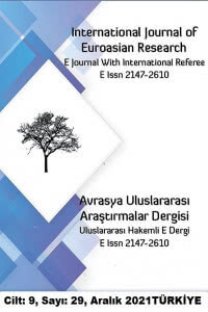SOĞUK SAVAŞ DÖNEMİ GÜVENLİK KAYGILARI ÜZERİNE GÖZLEMLER VE TARTIŞMALAR
OBSERVATIONS AND DISCUSSIONS ON THE SECURITY CONCERNS DURING THE COLD WAR
___
- Brams, Steve J., D. Marc Kilgour. 1986. “Is Nuclear Deterrence Rational”, Political Science & Politics 9 (3): 645-651.
- Freedman, Lawrence. 1986. “The First Two Generations of Nuclear Strategists”, Makers of Modern Strategy: From Machiavelli to the Nuclear Age, Ed. Peter Paret, Princeton: Princeton University Press.
- Gaddis, John Lewis. 1981. “Containment: Its Past and Future”, International Security 5 (4): 74-102.
- Gaddis, John Lewis. 2005. Strategies of Containment, 2nd edition, New York: Oxford University Press.
- Glaser, Charles L. 1997. “The Security Dilemma Revisited’’, World Politics 50 (1): 171- 201.
- Halliday, Fred. 2010. “The Cold War: Lessons and Legacies”, Government and Opposition 45 (1): 1-28.
- Halloway, David. 1981. “Entering the Nuclear Arms Race: The Soviet Decision to Build the Atomic Bomb”, Social Studies of Science 11 (2): 159-197.
- Herz, John H. 1950. “Idealist Internationalism and the Security Dilemma”, World Politics 2 (2): 157-180.
- Heuser, Beatrice. 1995. “The Development of NATO Nuclear Strategy”, Contemporary European History 4 (1): 37-66.
- Howard, Michael. 1985. “Blackett and the Origins of Nuclear Strategy”, The Journal of the Operational Research Society 36 (2): 89-95.
- Jervis, Robert. 1978. “Cooperation Under the Security Dilemma”, World Politics 30 (2): 167-214.
- Jervis, Robert. 2001. “Was the Cold War a Security Dilemma”, Journal of Cold War Studies 3 (1): 36-60.
- Kennan, George F. 1947. “The Sources of Soviet Conduct’’, Foreign Affairs 25 (4): 566-582.
- Kennan, George F. 1990. “America and the Russian Future”, Foreign Affairs 69 (2): 157-166.
- Kilgour, D. Marc, Frank C. Zagare. 1991. “Credibility, Uncertainty, and Deterrence”, American Journal of Political Science 35 (2): 305-334.
- Kydd, Andrew. 1997. “Game Theory and the Spiral Model”, World Politics 49 (3): 371- 400.
- Leffler, Melvyn P. 1984. “The American Conception of National Security and Beginning of the Cold War, 1945-48”, The American Historical Review 89 (2): 346-381.
- Leng, Russel J. 2000. Bargaining and Learning in Recurring Crises, Ann Arbor: University of Michigan Press.
- May, Ernest R., ed. 1994. American Cold War Strategy: Interpreting NSC-68, Boston: St. Martin's.
- McDonough, David. S. 2005. “Nuclear Superiority or Mutually Assured Deterrence: The Development of the US Nuclear Deterrent”, International Journal 60 (3): 811-823.
- Smith, Martin A. “British Nuclear Weapons and NATO in the Cold War and Beyond”, International Affairs 87 (6): 1385-1399.
- W.N. 1975. “NSC-68: A Report to the National Security Council”, Naval War College Review 27 (6): 51-108.
- W.N. 1999. “Newly Declassified Annexes of NSC-68”, SAIS Review 19 (1): 13-32.
- Wells, Jr. Samuel F. 1979. “Sounding the Tocsin: NSC 68 and the Soviet Threat”, International Security 4 (2): 116-158.
- ISSN: 2147-2610
- Yayın Aralığı: 4
- Başlangıç: 2012
- Yayıncı: Kürşat Öncül
EİSENHOWER DOKTRİNİ ÇERÇEVESİNDE BÖLGESEL KRİZLER: SURİYE- IRAK-ÜRDÜN-LÜBNAN
LOCAL GOVERNMENTS' CONTRIBUTIONS TO EDUCATION IN TURKEY
TÜRKİYE’DE ZEYTİN ÜRETİMİNDE MÜBADİLLERİN YERİ
ULUSLARARASI HUKUK AÇISINDAN MÜTAREKE KAVRAMI VE MONDROS MÜTAREKESİ
BÜYÜK DEVLETLERİN KAFKASYA’DA DEMİRYOLU VE PETROL POLİTİKASI
STRABON ve PLINIUS’UN PRUSA’NIN KURULUŞU HAKKINDAKİ GÖRÜŞLERİNE ELEŞTİREL BİR BAKIŞ
TÜRK-RUS İLİŞKİLERİ BAĞLAMINDA RUSYA’DA TÜRKOLOJİ’NİN TARİHSEL GELİŞİMİ
MOĞOLLAR ve TÜRKLER: TARİHSEL BAĞLAR
FUZÛLÎ’NİN TÜRKÇE GAZELLERİNDE KUR’ÂN-I KERÎM’DEKİ DİNÎ ŞAHSİYETLER
SURİYELİ SIĞINMACI ÇOCUKLARIN COVID-19 PANDEMİSİ SÜRECİNDE EĞİTİM HAYATINDA YAŞADIĞI SORUNLAR
